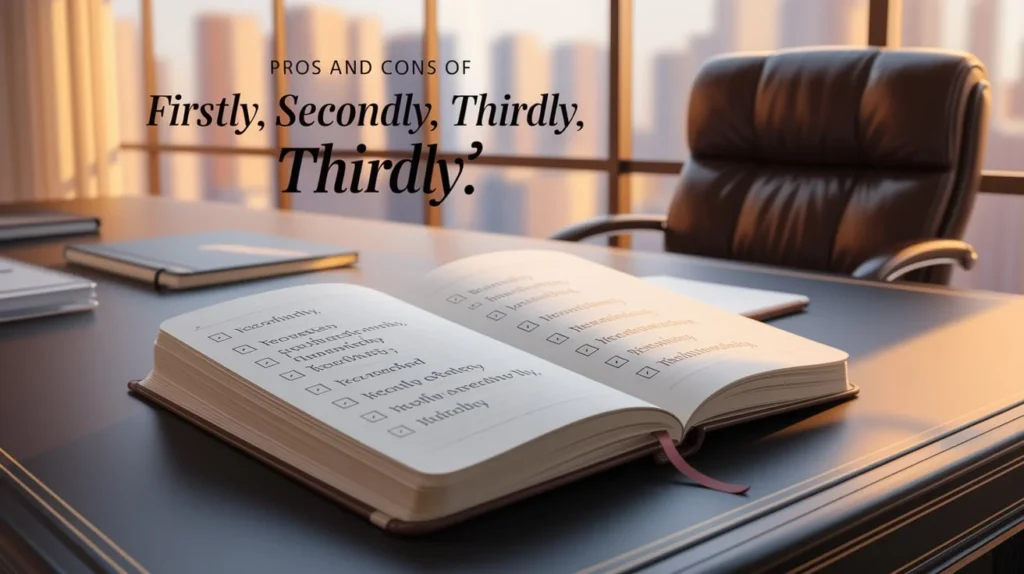Choosing the right words to organize thoughts clearly and naturally is crucial, whether you’re writing an email, an essay, or giving a presentation. While “Firstly, Secondly, Thirdly” are commonly used, they can sometimes feel repetitive or overly formal. By varying your transitions, you can make your communication sound more engaging and polished.
Here are 20 other ways to say ‘Firstly, Secondly, Thirdly’ to help you structure your points more effectively while keeping your tone warm and natural.
What Does “Firstly, Secondly, Thirdly” Mean?
“Firstly, Secondly, Thirdly” are sequencing words used to list points in a logical order. They help structure thoughts and create a smooth flow in writing or speech. While they are grammatically correct, they can sound robotic or overly structured in certain contexts. Exploring other ways to sequence ideas can make your writing sound more conversational and engaging.
Is It Professional/Polite to Say “Firstly, Secondly, Thirdly”?
Yes, using “Firstly, Secondly, Thirdly” is grammatically correct and widely accepted in both formal and professional writing. However, depending on the context, these words might come across as rigid or outdated. In business communication, for instance, using “To begin with, Next, Finally” or “First of all, Then, Lastly” can sound more natural.
Pros and Cons of Using “Firstly, Secondly, Thirdly”

Pros:
- Helps organize ideas clearly
- Works well in academic and formal writing
- Easily understood by most readers
Cons:
- Can sound stiff or formulaic
- Might not fit casual conversations
- Overuse can make writing repetitive
Synonyms For ‘Firstly, Secondly, Thirdly’
- To begin with, Next, Finally
- First of all, Then, Lastly
- First and foremost, After that, To wrap up
- One key point, Another key point, A final key point
- The first thing to note, Following that, In conclusion
- Starting, Moving on, To end with
- Let’s begin with, Afterward, In the end
- Initially, Subsequently, Ultimately
- At the start, Later, At the end
- Primarily, In addition, Lastly
- First up, Next up, Wrapping up
- First things first, On top of that, Finally
- A major point, Another important point, A final thought
- Beginning with, Advancing to, Concluding with
- Opening with, Progressing to, and Finalizing with
- A crucial point, An additional insight, A closing remark
- The initial step, The following step, The final step
- To kick things off, As we continue, To finish up
- As a starting point, Moving forward, Wrapping things up
- For starters, What follows, To close off
1. To Begin With, Next, Finally
This alternative sounds natural and is great for structured discussions.
Scenario Example:
Subject: Project Updates
Hey [Name],
To begin with, we have completed phase one of the project. Next, we’ll focus on testing and refining. Finally, we’ll implement the final version next month. Let me know if you have any questions!
Best,
[Your Name]
Best Use:
Great for professional and casual settings when listing steps in order.
Additional Note:
Works well in presentations and structured emails.
2. First of All, Then, Lastly
A conversational alternative that flows smoothly.
Scenario Example:
Subject: Proposal Outline
Hi [Name],
First of all, I’d like to thank you for your input. Then, we’ll refine the proposal based on feedback. Lastly, we’ll present it to the stakeholders. Let me know if you’d like any changes.
Thanks,
[Your Name]
Best Use:
Best for emails, reports, and discussions.
Additional Note:
Sounds polite and structured without being too formal.
3. First and Foremost, After That, To Wrap Up
Adds emphasis on the first point and keeps the sequence flowing naturally.
Scenario Example:
Subject: Important Meeting Agenda
Dear Team,
First and foremost, we need to discuss budget allocations. After that, we’ll review team performance. To wrap up, we’ll finalize the roadmap for the next quarter. See you all at the meeting!
Best,
[Your Name]
Best Use:
When listing priorities in an important discussion.
Additional Note:
Works well for business and leadership communications.
4. One Key Point, Another Key Point, A Final Key Point
A professional alternative that emphasizes key arguments.
Scenario Example:
Subject: Strategy Review
Hi [Name],
One key point to consider is customer engagement. Another key point is budget optimization. A final key point is timeline feasibility. Let’s discuss this further in our meeting.
Best,
[Your Name]
Best Use:
Ideal for business reports, persuasive emails, and strategy discussions.
Additional Note:
Keeps the focus on important takeaways.
5. The First Thing to Note, Following That, In Conclusion
A structured yet softer alternative.
Scenario Example:
Subject: Training Session Overview
Dear Team,
The first thing to note is the updated schedule. Following that, we’ll go over the new guidelines. In conclusion, we’ll open the floor for questions. Let me know if you have any concerns.
Best,
[Your Name]
Best Use:
Works well in detailed explanations and formal communication.
Additional Note:
Keeps transitions smooth and engaging.
6. Starting, Moving On, To End With
This phrase set offers a casual yet structured way to organize points.
Scenario Example:
Subject: Team Project Plan
Hi [Name],
Starting, we need to finalize the initial design. Moving on, we’ll integrate the feedback from stakeholders. To end with, we’ll test the final prototype before the launch. Let me know if you have any concerns.
Best,
[Your Name]
Best Use:
Works well for project updates, informal discussions, and presentations.
Additional Note:
Keeps the tone natural without sounding rigid.
7. Let’s Begin With, Afterward, In The End
This alternative is engaging and encourages a smooth flow of ideas.
Scenario Example:
Subject: Weekly Meeting Agenda
Dear Team,
Let’s begin with a review of last week’s progress. Afterward, we’ll discuss new action items. In the end, we’ll set deadlines for the upcoming tasks. See you at the meeting!
Best,
[Your Name]
Best Use:
Suitable for casual and semi-formal discussions.
Additional Note:
Helps create a conversational yet organized structure.
8. Initially, Subsequently, Ultimately
A more sophisticated alternative for structured discussions.
Scenario Example:
Subject: Research Proposal Update
Hi [Name],
Initially, we will focus on gathering relevant data. Subsequently, we’ll analyze the findings and compile a report. Ultimately, the goal is to publish our research in a recognized journal. Let me know if you have any input.
Best,
[Your Name]
Best Use:
Best for academic writing and professional reports.
Additional Note:
Sounds polished and suitable for formal contexts.
9. At The Start, Later, At The End
A simple and effective way to list points.
Scenario Example:
Subject: Training Session Breakdown
Hi Team,
At the start, we’ll go over the basics. Later, we’ll dive into advanced techniques. At the end, we’ll have an open Q&A session. Looking forward to it!
Best,
[Your Name]
Best Use:
Great for workshops, training sessions, and explanatory emails.
Additional Note:
Keeps things easy to follow.
10. Primarily, In Addition, Lastly
A balanced alternative for professional writing.
Scenario Example:
Subject: Budget Allocation Discussion
Hi [Name],
Primarily, our focus should be on marketing expenses. In addition, we must allocate funds for software upgrades. Lastly, we need to review contingency funds. Let me know your thoughts.
Best,
[Your Name]
Best Use:
Works well in formal discussions and financial planning.
Additional Note:
Adds a professional yet readable tone.
11. First Up, Next Up, Wrapping Up
This alternative is ideal for informal and engaging discussions.
Scenario Example:
Subject: Event Planning Timeline
Hey [Name],
First up, we need to confirm the venue. Next up, we’ll send out invitations. Wrapping up, we’ll finalize catering and logistics. Let me know if I missed anything!
Best,
[Your Name]
Best Use:
Perfect for event planning and casual team discussions.
Additional Note:
Adds a friendly and dynamic touch.
12. First Thing’s First, On Top of That, Finally
A conversational alternative for listing priorities.
Scenario Example:
Subject: Action Items for the Week
Hi Team,
First things first, we need to complete the pending reports. On top of that, let’s review the client feedback. Finally, we should prepare for next week’s presentation. Let me know if you have any updates!
Best,
[Your Name]
Best Use:
Great for prioritizing tasks in casual business emails.
Additional Note:
Keeps things light yet structured.
13. A Major Point, Another Important Point, A Final Thought
An excellent way to highlight key arguments.
Scenario Example:
Subject: Policy Update Discussion
Dear [Name],
A major point to consider is the impact on customer service. Another important point is the budget implications. A final thought is how this aligns with company goals. Let’s discuss this further.
Best,
[Your Name]
Best Use:
Works well in strategic discussions and analytical writing.
Additional Note:
Keeps the focus on critical takeaways.
14. Beginning With, Advancing To, Concluding With
A professional transition alternative.
Scenario Example:
Subject: Research Plan Outline
Hi [Name],
Beginning with data collection, we’ll ensure a strong foundation. Advancing to analysis, we’ll interpret the findings. Concluding with recommendations, we’ll finalize our report. Let me know your thoughts!
Best,
[Your Name]
Best Use:
Suitable for academic, research, and technical writing.
Additional Note:
Keeps transitions fluid and professional.
15. Opening With, Progressing To, Finalizing With
A smooth and structured way to guide discussions.
Scenario Example:
Subject: Presentation Agenda
Dear Team,
Opening with an overview, we’ll introduce key topics. Progressing to case studies, we’ll provide real-world examples. Finalizing with takeaways, we’ll summarize the discussion. Looking forward to your input!
Best,
[Your Name]
Best Use:
Ideal for presentations and structured documents.
Additional Note:
Works well in both written and spoken formats.
16. A Crucial Point, An Additional Insight, A Closing Remark
This structured approach helps emphasize key thoughts while keeping transitions smooth.
Scenario Example:
Subject: Proposal Discussion Points
Hi [Name],
A crucial point to address is the project timeline. An additional insight to consider is the cost breakdown. A closing remark is that our success depends on strategic execution. Looking forward to your feedback.
Best,
[Your Name]
Best Use:
Perfect for structured discussions, presentations, and professional reports.
Additional Note:
Creates an engaging and well-balanced flow of ideas.
17. The Initial Step, The Following Step, The Final Step
This alternative works well for instructional or step-by-step explanations.
Scenario Example:
Subject: Onboarding Process Overview
Hi [Name],
The initial step is setting up login credentials. The following step is completing the training modules. The final step is attending the Q&A session. Let me know if you need assistance.
Best,
[Your Name]
Best Use:
Great for step-by-step instructions and process documentation.
Additional Note:
Ideal for guiding someone through a structured process.
18. To Kick Things Off, As We Continue, To Finish Up
A friendly, conversational way to organize information.
Scenario Example:
Subject: Marketing Strategy Discussion
Hey [Name],
To kick things off, let’s review last quarter’s performance. As we continue, we’ll explore new campaign ideas. To finish up, we’ll assign action items. Let me know if this works for you.
Best,
[Your Name]
Best Use:
Works well for informal meetings and brainstorming sessions.
Additional Note:
Keeps the tone light and engaging while maintaining structure.
19. As a Starting Point, Moving Forward, Wrapping Things Up
A great way to smoothly transition between ideas while keeping things fluid.
Scenario Example:
Subject: Client Meeting Agenda
Dear Team,
As a starting point, we’ll address the client’s key concerns. Moving forward, we’ll propose solutions. Wrapping things up, we’ll confirm the next steps. Please come prepared with relevant data.
Best,
[Your Name]
Best Use:
Suitable for business discussions and project updates.
Additional Note:
Keep communication clear and purposeful.
20. For Starters, What Follows, To Close Off
A natural and informal way to structure information.
Scenario Example:
Subject: Workshop Schedule Overview
Hi Everyone,
For starters, we’ll begin with an introduction session. What follows is a hands-on group activity. To close off, we’ll have a feedback discussion. Looking forward to an engaging session!
Best,
[Your Name]
Best Use:
Perfect for casual and engaging communication, such as events or team activities.
Additional Note:
Helps maintain a friendly and approachable tone.
Conclusion
Finding the right alternative to “Firstly, Secondly, Thirdly” allows for more natural, engaging, and dynamic communication. Whether you’re writing an email, report, or presentation, these alternatives provide clarity, structure, and warmth to your message.















